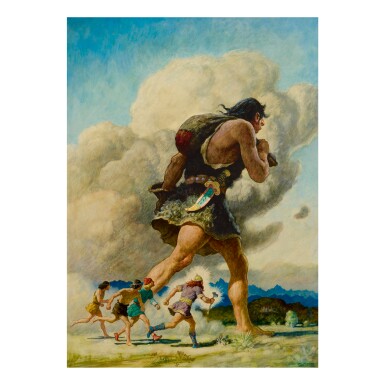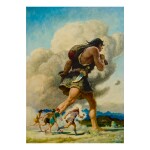American Art
American Art

Property from a Private California Collection
N. C. WYETH | THE THREE FRIENDS
Auction Closed
November 19, 04:22 PM GMT
Estimate
300,000 - 500,000 USD
Lot Details
Description
Property from a Private California Collection
N. C. WYETH
1882 - 1945
THE THREE FRIENDS
signed N.C. WYETH (lower right)
oil on Renaissance panel
28 ½ by 20 ½ inches
(72.4 by 52.1 cm)
Painted circa 1939.
The artist
Dr. George Arthur Stetson, West Chester, Pennsylvania, 1946
Dr. George Edward Stetson, Bloomsburg, Pennsylvania (by descent)
By descent to the present owner
N.C. Wyeth, Income tax notes for 1940, unpublished (Brandywine River Museum of Art)
Edna Johnson and Carrie E. Scott, eds., "Thor's Wonderful Journey," Anthology of Children's Literature, Boston, Massachusetts, 1940, illustrated p. 340
Douglas Allen and Douglas Allen, Jr., N.C. Wyeth: The Collected Paintings, Illustrations and Murals, New York, 1972, p. 208
Christine B. Podmaniczky, N.C. Wyeth: Catalogue Raisonné of Paintings, vol. II, London, 2008, no. I.1258, p. 568, illustrated
Wilmington, Delaware, The Wilmington Society of the Fine Arts, N.C. Wyeth, N.A. 1882-1945, Memorial Exhibition, January 1946, no. 30
N.C. Wyeth painted the present work as an illustration for “Thor’s Wonderful Journey” in the 1940 edition of Edna Johnson and Carrie Scott’s Anthology of Children’s Literature. First published in 1882 as part of Norse Stories Retold from the Eddas by Hamilton Wright Mabie, “Thor’s Wonderful Journey” recounts one of the fables of Thor, the Norse god of thunder and one of the most prominent figures in Germanic mythology.
In The Three Friends, Wyeth depicts Thor, wielding his emblematic hammer and emanating bolts of lightning as an indication of his superhuman strength, and his three companions trailing after Skrymer, a giant renowned for his deceit. Mabie describes Thor’s quest: “Thor made many journeys and had many strange adventures; but there was one journey which was more wonderful than all the others, and which proves, moreover, that the strongest and truest are sometimes deceived by those who are weaker than themselves. The giants in old Norse times were not easy to conquer; but generally it was when they hid themselves behind lies and appeared to be what they were not that they succeeded for a time. Thor’s strength was a noble thing because he used it to help men; but his truthfulness and honesty were nobler still” (Norse Stories Retold from the Eddas, New York, 1882, n.p.).
Wyeth was particularly respected for the spirit of adventure he could seamlessly conjure in his images, which not only complemented but also enhanced a narrative. Indeed, Wyeth skillfully renders each element of the composition and instills The Three Friends with a palpable energy. As the artist himself said, “Convincing illustration must ring true to life. The characters should be flesh and blood, not puppets who strike attitudes for the sake of composition, or manikins which serves as drapes for clothes, however effective the costumes in themselves may be” (as quoted in Douglas Allen and Douglas Allen, Jr., N.C. Wyeth: The Collected Paintings, Illustrations and Murals, New York, 1972, p. 128).
